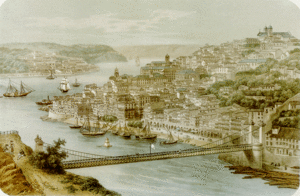Ponte pênsil
Coordinates: 41 ° 8 ′ 26 " N , 8 ° 36 ′ 36" W.
| Ponte pênsil | |
|---|---|
| Official name | Ponte D. Maria II |
| Crossing of | Douro |
| place | Porto - Vila Nova de Gaia |
| construction | Suspension bridge |
| width | 6 m |
| Longest span | 170 m |
| Clear height | 10 m |
| start of building | 1841 |
| completion | 1843 |
| planner | Stanislas Bigot |
| closure | Dismantled in 1887 |
The Ponte pênsil ( suspension bridge ) was the first permanent bridge over the Douro between Porto and Vila Nova de Gaia .
Not only colloquially, but also in literature it was only called ponte pênsil , although its official name was Ponte D. Maria II (after Maria II , the ruling queen of Portugal when it was built). An inscription and the date 1842 on the iron crossbar between the pylons reminded of this.
It stood about 80 meters above its predecessor, the Ponte das Barcas , and immediately below the later Ponte Dom Luís I , from which it was replaced. At this point rocky outcrops narrowed the river to 155 m.
The suspension bridge had a span of 170.14 m. With its height of 10 m above the usual water level, it was safe from flooding. Pylons in the shape of ancient obelisks formed the entrance to the bridge. They were made of natural stone blocks and were 18 m high. As carrying ropes, four iron parallel wire ropes were stretched over the pylons on both sides , which were anchored in the ground behind the pylons. The 6 m wide roadway, which was supported on trusses, was made of tarred fir wood . Iron railings also served to stabilize the bridge.
The bridge was built according to the plans and under the direction of the engineer Stanislas Bigot . The ceremonial start of construction took place on May 2, 1841, the day of the (first) coronation of the queen. The construction work on the bridge and the subsequent load tests were completed on January 4, 1843; The provisional traffic release took place on the same day. A grand opening was planned for February 1843 after the clean-up had been completed, but a surprising flood on February 17th forced the Ponte das Barcas to be dismantled and the bridge finally opened.
The bridge was built by workers who had never worked with a suspension bridge but were praised by Bigot for their consistent and careful execution of the instructions. The materials were procured from all over Europe: cast iron parts came from England , wrought iron was bought locally but came from Norway , heavy iron parts came partly from France , partly from England, the wires for the suspension ropes were delivered from Besançon and the firs for the Roadway had been bought in Stockholm . The bridge was built without a single accident.
The Ponte Pensil was established in 1887 after the opening of Ponte Dom Luis I dismantled. Today only the two obelisks next to this bridge remind of her.
Web links
- Stanislas Bigot: Pont suspendu de Porto . Details des travaux, suivi de trois planches explicatives. José Baptista Morando, Lisboa 1843 ( full text in the Google book search).
- Le pont suspendu de Stanislas Bigot à Porto, Portugal. Historic photo in: Ponts suspendus anciens disparus
